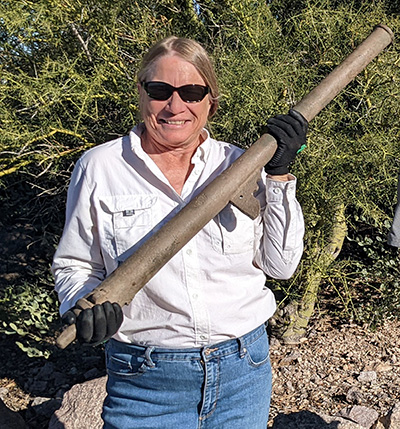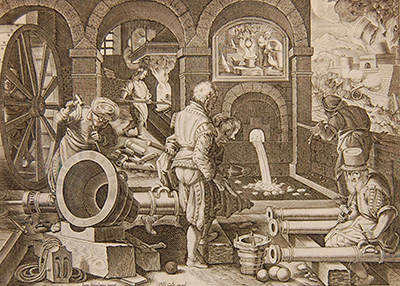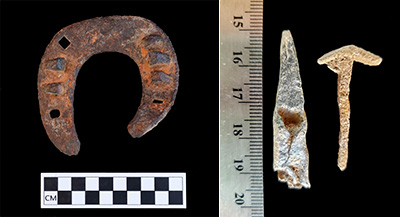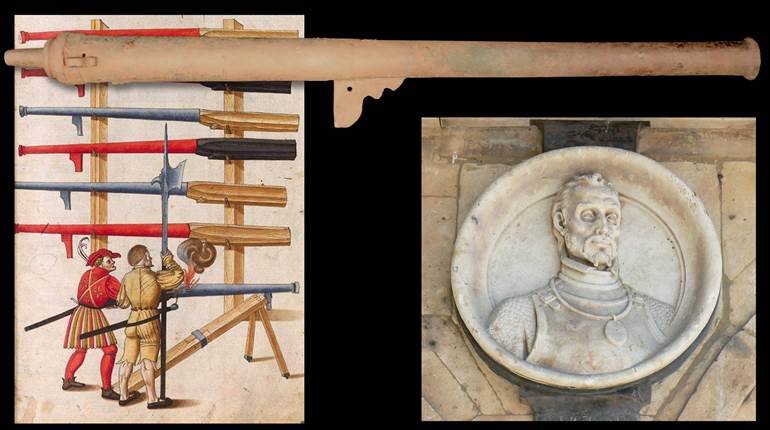
In 1540, Spanish conquistador Francisco Vázquez de Coronado set off from what is now central Mexico and entered the United States through southern Arizona in his search for the fabled “Seven Cities of Gold” in the American Southwest. Ultimately, the Coronado expedition traveled as far north as Kansas before returning to Mexico City in 1542. In a groundbreaking discovery that will change the history books, an abandoned town that Coronado established in 1541 along his route has recently been found in the Arizona desert. Wind and rain had erased all obvious traces of this town over time, but one of Coronado’s six wall guns was recently found at the site, where it was lost in a battle 480 years ago with the local natives, the Sobaipuri O’odham, irrigation farmers who lived in permanent settlements along most of the rivers in southeastern Arizona. It is they, not the Ópata as scholars have thought, who repulsed the Spaniards at this early date.
The Coronado gun is the oldest firearm ever found inside the continental United States and is also the first firearm found from this roughly 2,500-person expedition. The design of the small cannon, called a “hackbut” by some, is from the mid-to-late 1400s, and it was practically obsolete when the expedition started. It is a rampart or wall gun, wherein the right-angle hook on the bottom of the barrel was placed on the off side of a rampart wall to take up the recoil when fired. Alternatively, it could be fired in an open field using a portable tripod made of stout wooden planks; the crotch of a tree would also have served in a pinch.

The site where the cannon was found is believed to be the first purpose-built settlement in the American Southwest (referred to as a villa [town] in the Spanish documents). It is believed to be Coronado’s northernmost effort at establishing an actual town, and evidence shows it to be named San Geronimo III. The places they stayed farther north in the Pueblo area were all referred to as camps or quarters and were not given the official legal designation of “town.” “San Geronimo” may have been specified in the expedition’s charter as the name required for a permanent town in the New Land. As the Coronado expedition passed through this region heading north when it established this settlement, about 40 of the Spanish horsemen, along with their squires, slaves and perhaps families were left behind, the total number being about 200 to 400 people. They used this place to erect buildings, establish a formal presence in the area on behalf of the church and king, take care of the sick and offload some of the expedition’s troublemakers.
After about six to 12 months, the town was attacked by the local natives, who were spurred to violence following a train of abuses, including the Europeans taking their wives and daughters as sex slaves, stealing their food and lopping off their noses, tongues and hands for minor offenses. Many of the town’s population were killed, and the survivors were forced to flee. One historical account suggests that the battle was over quickly, with the natives surprising the Spanish in the early morning, implying that many were killed in their beds. Another account indicates that the battle lasted a bit longer. The rampart gun was found on the floor of a collapsed mud-and-rock-walled structure that was in the center of the town and battlefield. It seems the roof of this structure was set on fire, and a wall collapsed on top of the gun, preserving it to this day. Carbon-14 dating of charcoal and luminescence dating of an unusual pottery sherd from inside the structure place this gun and the structure squarely in the Coronado time period.
Crossbows with steel bolts were also used by the Spanish on this expedition, and, so far, 80 expended copper and iron crossbow bolt heads and arrow points have been found in the vicinity of this building and elsewhere around the site. These are the first iron specimens ever found for the Coronado expedition. Pieces of other firearms and ammunition were found elsewhere around the townsite where the Spanish fought before fleeing for their lives. Matchlock arquebus parts, wheellock parts, ringlets from chainmail armor, rivets from plate armor and pieces of broken swords and daggers were also found, among other items. One account says that only six Spaniards survived the attack, aided by a priest who fiercely defended others with a broadsword during the chaos. These survivors fled the town, marking the first time that American Indians defeated and totally routed the Spanish in North America. Indeed, no European expeditions came back to southern Arizona for about 140 years.
Archaeologists have been debating the exact route of Coronado’s march for more than 100 years, because the original journal entries were not clear. No other sites had been confirmed anywhere in Arizona or along the first 1,500 miles of the expedition from Sinaloa, Mexico to Zuni, New Mexico. Archaeologist Deni Seymour has been studying the old manuscripts, surveying and doing terrain analysis in southern Arizona for more than 30 years looking for Coronado sites. However, the site was discovered following the identification of a specific type of iron nail used in the early 1500s, found only at other Coronado sites in Arizona and those dating back to the 1500s in other states. It seems the expedition was carrying hundreds, if not thousands, of these. It is a simple hand-forged nail, called a gable-headed nail or a “two-strike” nail, that was used for a variety of purposes, but most importantly for horseshoes. Seymour next learned that some had been found somewhere in the county, along with a piece of a medieval horseshoe, so the next step was to locate the specific ranch where they were found. On a hunch with good detective work, and leaning on past experience and terrain analysis, she found the source of the nails with the help of a metal detector. The cannon and hundreds of other artifacts were discovered in short order. This is the first time Coronado’s entry point into the USA can be confirmed with archaeological artifacts, including crossbow bolt heads, gable-headed nails and hundreds of other items, as well as Carbon-14 and luminescence dating results from structural features.

The Hackbut Cannon
The rampart or wall gun is 42" long with a 0.873" (7-gauge) smooth bore. It is made of cast bronze and weighs about 40 lbs., and it is stout enough to handle heavy charges of buckshot or lead round balls. A single ball would have weighed about 775 grains, and sometimes two balls were loaded at once. Second-generation refined blackpowder, not serpentine powder, was in use at that time. The gun was meant to be fired by hand with a slow-burning match cord, and it had no lock mechanism. There is a flat ledge next to the touchhole on which to place the priming powder, but, interestingly, the pan is not dished out to keep the powder in place while aiming, moving or when the wind was blowing. The conical projection at the rear of the gun (cascabel) was meant to accept a “tiller,” or short wooden pole, to help aim the piece by placing the pole either under the armpit or over the shoulder of the gunner. The wooden pole had a socket in the end to press-fit it onto the conical cascabel. There was no half- or full-length gunstock as such. Loading, aiming and shooting the gun was almost certainly a two-man operation, although one well-trained gunner could handle it in an emergency.

The six rampart guns, called versillos—the diminutive form of verso (a type of cannon)—in the historical record, were brought along on the expedition for three reasons. The first was for shock effect directed toward the natives who had never seen firearms. As conveyed in an account of a later expedition, they blasted trees to demonstrate the expedition’s strength of force as a preventive measure when the natives contemplated attacking. Another reason is because they were traveling to unknown lands, and they expected to encounter cities with wooden or light mud brick walls that would need to be breached. Instead, in this particular area in southern Arizona, they only encountered natives living in houses made of branches, reed mats and mud. The third reason is that firearms of this size were extremely versatile and highly portable, and they were good for both offense and defense in rough terrain.

We believe that two of the six total rampart guns in the expedition were left behind on Coronado’s orders to defend the town and local mining interests. The town was more than one kilometer long, so one gun would likely have been insufficient. This means that four were carried farther north, as an expedition-related historical document suggests. Two round balls of the approximate diameter that it fired have been found at other Coronado battlefield sites in New Mexico. Each of the guns would probably have been slightly different in appearance and even bore diameter, given the crude bronze sand-casting techniques utilized. The gun pictured here was cast horizontally through three sprue holes simultaneously.
It was not loaded when found by Dr. Seymour. In addition, no lead balls of this size have yet been discovered at the site, which leads us to believe that this wall gun was primarily used with buckshot, or “swan shot” as it was called back then, because people of this era ate swans as game animals. The gun also has no sights, which supports the buckshot theory. A maximum load of about 4 ozs. of No. 4 buckshot (86 pellets of .24 caliber) would have made for a devastating load against a formation of lightly clad natives. At 1,125 f.p.s., a load of No. 4 buckshot will fly about 460 yards when fired at a 35-degree angle. Buckshot can wound a man at well over 100 yards, and even a single pellet, depending on where it hits, can put someone out of action. A rough estimate as to the distance that a single large bore-size lead round ball could travel when shot would be about 650-750 yards when fired at a 35-degree angle. For comparison, a typical 12-ga. shotgun slug today will travel 817 yards with a muzzle velocity of 1,600 f.p.s.
Numerous round and deformed lead projectiles of all sorts have been found at the site, some no doubt from the Spaniards’ matchlocks, wheellocks and perhaps from the wall gun itself. The metallurgical analysis of these projectiles is underway. With both the wall gun and the lead shot, we hope to be able to determine whether they were cast in Spain, or perhaps in what is now Mexico, by chemically matching the alloys to known ore-producing regions. Preliminary analysis of the wall gun reveals a lack of lead in the bronze mixture, which is consistent with the signature of having been made in Mexico. If so, then this is the oldest surviving firearm actually made in the New World, firmly dated to 1540, and perhaps made two decades earlier in Mexico by Conquistador Hernán Cortés.

How accurate were such wall guns? Large smoothbore guns without sights firing a lead round ball can generally hit a man-size target at about 50-100 yards. A group of men in a battle formation could be hit much farther, and the solid round ball would be deadly out to the maximum range of the gun. The rate of fire for the gun would be two to three shots per minute with a trained gun crew, until the blackpowder fouling in the barrel forced them to stop and clean it out. Six to 10 shots would be about right, depending on the diameter of the ammunition, type of wads and the amount of powder used. Some cannons were swabbed after each shot, but in a hot, close fight, this was often ignored.
On the trail, the wall gun barrel was transported lashed to a mule or horse, along with the heavy wooden tripod. The hole in the right-angle hook under the barrel was a tie-down point and was also used to hold match cord. At least one other animal would probably have been needed to transport the lead balls, buckshot, powder, ramrods and cleaning accessories. There were no wheeled carts, wagons or caissons on this expedition, so everything was carried by either animals or humans. This is ultimately why they carried very light artillery pieces.
Now that the Coronado expedition has been anchored to a known point on the ground, other Coronado sites are being discovered along the trail to the northeast. The expedition consisted of about 400 Spanish soldiers, several hundred servants and camp followers, as well as about 1,500 native allies from what is now Mexico. They were driving thousands of head of livestock along this route, such as cattle, sheep, pigs and extra horses, so their progress must have been fairly slow. Modern-day cowboys and livestock wranglers were asked to help estimate how far this herd of animals could travel in a day. This and other analyses caused Dr. Seymour to look for sites at that distance that had sufficient water and fodder. As a result, four new campsites have recently been discovered. Work will continue at this archaeological site for years to come, and a professional documentary film crew has been involved in capturing the discovery.
This archaeological effort is privately funded with no grants, charters or support from universities. To support the excavation and the search, or the film (specify which), tax-deductible donations are accepted at:
Arizona Coronado Project (You must specify this project.)
Old Pueblo Archaeology Center
P.O. Box 40577
Tucson, AZ 85717-0577
(520) 798-1201



































